
Text by Nicole Bouglouan
Photographers:
Roger Ahlman
Pbase Galleries Peru and Ecuador
Alfredo Colón
Puerto Rico Wildlife
Patrick Ingremeau
TAMANDUA
Tom Merigan
Tom Merigan’s Photo Galleries
Otto Plantema
Trips around the world
Alan & Ann Tate
AA Bird Photography
Sources:
HANDBOOK OF THE BIRDS OF THE WORLD vol 1 by Josep del Hoyo-Andrew Elliot-Jordi Sargatal - Lynx Edicions - ISBN: 8487334105
OISEAUX DE LA REUNION par Armand Barau - Nicolas Barré - Christian Jouanin - Editions Orphie - ISBN : 2877632636
L’ENCYCLOPEDIE MONDIALE DES OISEAUX - Dr Christopher M. Perrins - BORDAS - ISBN: 2040185607
BirdLife International (BirdLife International)
Animal Diversity Web (University of Michigan Museum of Zoology)
Wikipedia, the free encyclopaedia
CREAGUS@Monterey Bay (Don Roberson)
The surprising flight strategy of magnificent frigatebirds
Red List of Threatened species
FREGATIDAE FAMILY
Order Suliformes
Frigatebirds
The frigatebirds form a small family of five closely related species, placed in a single genus, Fregata. These highly aerial seabirds are really designed for a predominantly aerial life with streamlined body, long, narrow wings, deeply forked tail, small rounded head, short neck and long bill. They are strictly marine and frequent both coastal and pelagic waters. They can be found in the warm seas and oceans of the tropics and subtropics where there are available food resources and especially flying fish, and suitable wind regime adapted to their soaring and gliding behaviour.
Although being very similar in appearance, each species shows some distinctive physical features allowing a better identification at closer range. The bright red gular pouch of males becomes conspicuous during the courtship displays when it is fully inflated, whereas the females have duller plumage and often white areas on the underparts. The young birds usually have buff to apricot head and neck and browner plumage.

The males have black plumage overall with blue, purple and green gloss on head, neck and mantle, and more or less white markings on the underparts, from white belly in the Christmas Frigatebird, to small white crescents on axillaries in the Lesser Frigatebird. Outside the breeding season, the red gular pouch is much reduced. The long, hooked bill is dark grey to blackish, the eyes are dark brown with dark eyering, the legs and partially webbed feet are blackish.
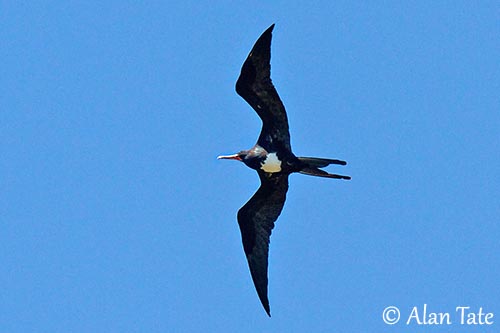
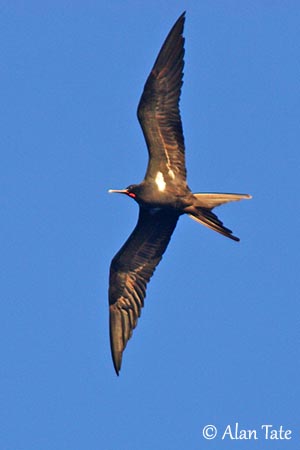
Male
The females have blackish-brown plumage on head and upperparts with little gloss, but the underparts often show a fairly large white area from lower breast to lower belly. However, the dark morph female of the Ascension Frigatebird differs from the male only by the brown pectoral band, present in the pale morph too. The bill is pale bluish-grey to pale pink, the dark eyes are surrounded by pinkish-red eyering (purplish-blue in Magnificent Frigatebird), legs and feet are mostly pinkish.
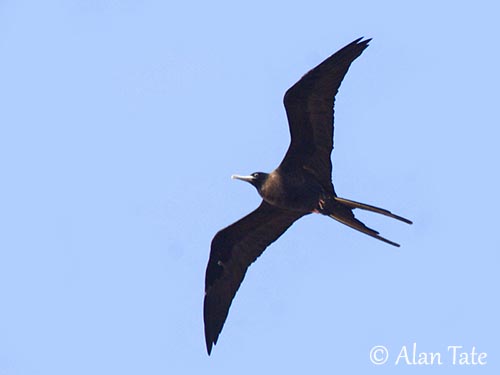
Dark morph female
The chick hatches naked, but it is soon covered with white down. The juveniles have extensive white on head and underparts. The young Great Frigatebird has variable amount of tawny-apricot tinge on head, neck and breast. Immature birds show complex series of plumages with tawny and white on head and breast, and white underparts, decreasing progressively to reach the adult plumage.
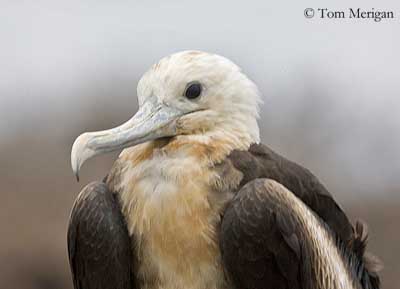
Juvenile
Except the Lesser Frigatebird with a wingspan of 193 centimetres, the four other species have a wingspan of more than two metres, up to 244 centimetres for the Great Frigatebird. With a weight ranging from 955 to 1640 grams, the frigatebirds have a low wing-loading with low weight in contrast with large wing area, making them very agile in flight.
They use the thermal currents for soaring and gliding at great heights, performing a few wingbeats to conserve the energy. This type of flight is effortless under right conditions, and allows them to travel very long distances. On calm days, they perform active flight with series of deep, loose wingbeats.
They can be seen riding along on the front of a storm for taking advantage of the wind, and even riding out heavy storms.
From an observation, groups of Lesser Frigatebirds breeding on St Brandon Island situated 268 nautical miles NE of Mauritius, were seen in Saint-Benoit and La Saline (Reunion), on January 7th - 1981. They travelled more than 600 kilometres in only 36 hours, pushed by the Tropical cyclone Florine.
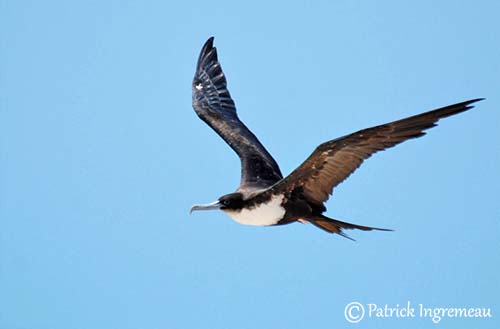
Female
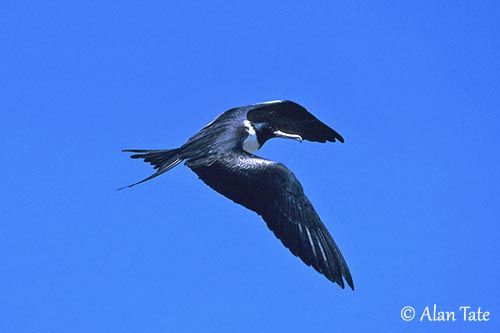
Female
The frigatebirds are able to spend several days and nights in flight. However, they are very clumsy on land, and it is very difficult for them to take off from the ground and almost impossible from the water. They usually nest in trees where they can perch and take flight more easily, but sometimes on the ground too. The Ascension Frigatebird nests exclusively on the ground, not presumably through preference but rather by force of circumstances, due to the habitat type.
In the same way, the frigatebirds do not swim or dive. They obtain the food by dipping while flying low over the water and catch the prey with the bill off the water surface. These birds lack of waterproof plumage and cannot feed underwater.
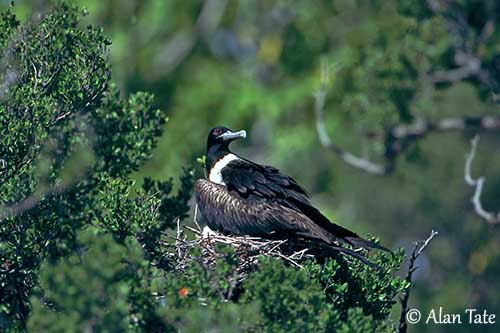
Female on the nest
They feed primarily on flying fish of genera Cypselurus and Exocoetus. But they also take cephalopods, especially squid, jellyfish and large plankton. They usually search for preys alone or in pairs, but large flocks can be seen at abundant food sources. Once detected, the prey is snatched off the water surface by surface-dipping. These birds rarely immerse more than the bill and sometimes the head while flying low over the water or occasionally hovering.
Eggs and chicks of other seabirds (terns, boobies, petrels and shearwaters) are also snapped up by swooping down and grabbing the prey in passing. The frigatebirds follow the fishing boats for fish scraps and congregate around slaughterhouses and other similar places. Competition for food often involves interactions and chases between the birds.
But frigatebirds are well known for their piratical habits, and numerous seabirds are harassed and robbed by waiting frigatebirds, forcing the victims to release the recently caught preys. Occasionally, this behaviour may really be the main source of food according to the season.
Unlike most of other seabirds, the frigatebirds drink fresh water when it is available. They drink while flying, by swooping down on pools and scooping up the water with the bill.
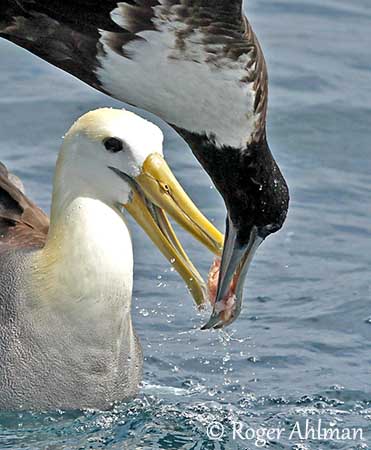
Harassing a Waved Albatross
Frigatebirds are largely diurnal and spend most of their time in the air. They leave the nightime roost at dawn and climb in the sky, usually very high, and start to search for food at sea, alone or in small groups. They return in the early afternoon and stay in the air over their roosts until just before dark. These birds are very gregarious and usually roost with other seabird species in trees, bushes, cliffs and sand-bars, although they also frequently spend all the night on the wing.
During the day, they can rest for hours on perches in the sun and preening. They bathe in flight by splashing the body repeatedly onto the water surface.
They can be seen sometimes in “sunbathing” posture with the wings wide open to expose the underside. This behaviour is used to dissipate excess heat, a common problem for tropical birds.

Frigatebirds have one of the longest breeding cycles of all seabirds, and they breed only every two years. The chicks are growing slowly and the post-fledging care is long. The breeding season usually starts with the dry season or a period of abundant food resources, with some variations depending on the range.
They often breed on islands in large colonies, up to several thousand pairs. However, some species such as the Ascension Frigatebird have tiny breeding range and numbers are much smaller.
Except the latter which nests exclusively on the ground due to the habitat type, the four other species nest both on the ground and in trees, up to 20 metres above the ground like the Christmas Frigatebird.
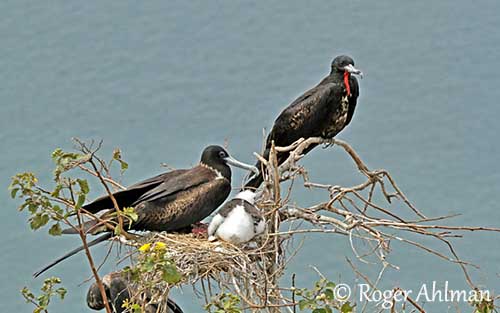
Pair and chick at nest
Frigatebirds have spectacular courtship displays. The males displays in groups of up to 30 birds. No aggression between them and they can tolerate even physical contact during the displays.
The wings are wide open to reveal the underside, while the bright red gular pouch is inflated. The head is tipped back and the bill is pointed skywards. As they are very conspicuous, they attract the females. When a female flies overhead, they quiver wings and head, while the bill is vibrating against the fully inflated pouch, producing a drumming noise.
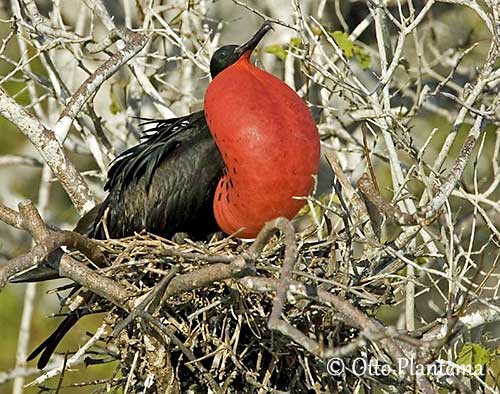
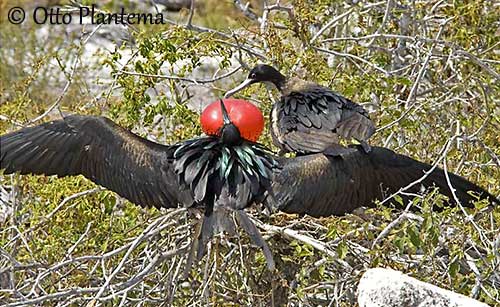
Male
Displaying male and female
When a female chooses a male, she flies down to join him. Pair-formation involves some ritual displays such as “head-snaking” or the male takes the female’s bill in its own. They are monogamous.
These displays are accompanied by sounds, as the displaying males are particularly noisy when they perform bill-clattering against the inflated pouch. Males and females have distinctive vocalizations, but the typical noises include twittering, drumming, rattling and whinnying. The young birds squeal and chirp while begging for food.
Pair
Once the pair is formed, both mates build the nest. The male provides nest materials to the female. Sticks, twigs, grass, seaweed, feathers can be used by the female to build a platform in tree or bush. The nests-site is strongly defended with bill-clattering or bill-grappling against intruders trying to steal materials. The copulation takes place at the nest-site, always preceded by “head-wagging”.
Three weeks later, the female lays a single, dull white egg. Both adults have brood patches and share the incubation during about 44-55 days, taking turns of one to four days on average. But this period depends on the food availability and the difficulty for the birds to find food.
At hatching, the chick is naked and helpless, but a thick white down soon grows. It is guarded in the nest during the first weeks, but when about a month old, it is able to defend itself against intruders. The chick is fed by its parents by regurgitation, but sometimes, it may have to wait three days or more before to be fed. It fledges about 5-7 months after hatching. Then, the post-fledging care may last 9-12 months, although Christmas Frigatebird and Great Frigatebird may have longer period of 15-18 months.
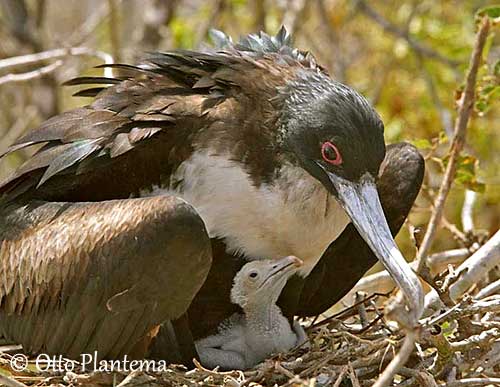
Female and chick at nest
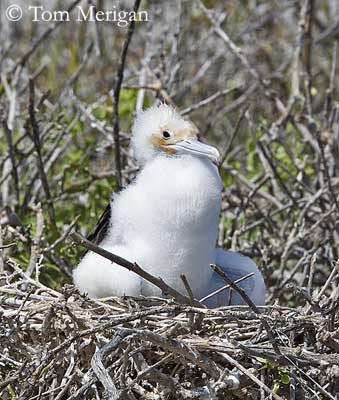
Chick
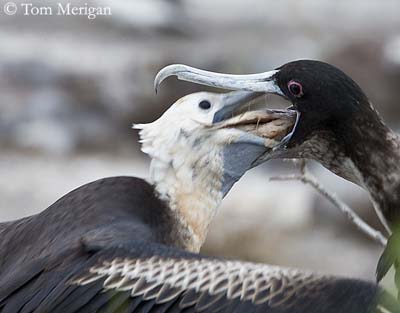
Female feeding the juvenile
During this period, the juvenile is roaming around the colony, taking advantage of unattended chicks or eggs and scraps. But it returns to the nest to be fed. Due to increasing difficulties to find enough food for parents and their juvenile, many chicks die of starvation.
The five species are mainly sedentary, remaining in the vicinity of their breeding colonies. The young birds may disperse over wide areas. The American birds are wandering up and down both Atlantic and Pacific coasts, whereas the Lesser Frigatebird from Central Pacific follows the prevailing winds round the SE Pacific. They can travel huge distances over the oceans. They may occasionally move over land, and the Magnificent Frigatebird regularly crosses the Isthmus of Panama.
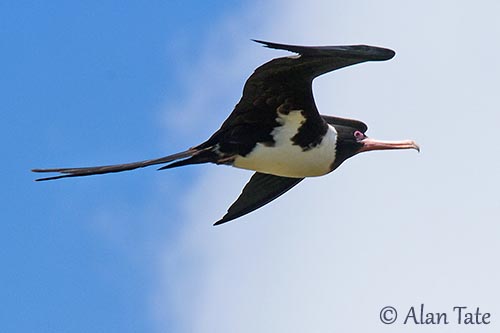
Female
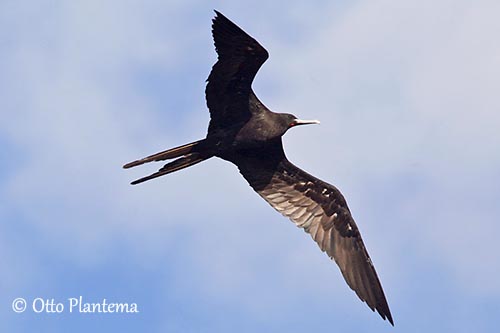
The Ascension Frigatebird occurs on Ascension Island in South Atlantic. This species is classified as Vulnerable.
The Christmas Frigatebird breeds on Christmas Island in E Indian Ocean and forages in the surrounding waters. It is considered as critically Endangered with decreasing population.
The Magnificent Frigatebird occurs on both Pacific and Atlantic coasts of America, from California to Ecuador and Galapagos, and from Florida to S Brazil. This species is currently evaluated as Least Concern.
The Great Frigatebird has wide distribution throughout the tropical seas in Pacific, Indian and Atlantic Oceans. They are not globally threatened and evaluated as Least Concern.
The Lesser Frigatebird occurs over tropical and subtropical waters, across Pacific, Indian and Atlantic Oceans. It is currently evaluated as Least Concern.
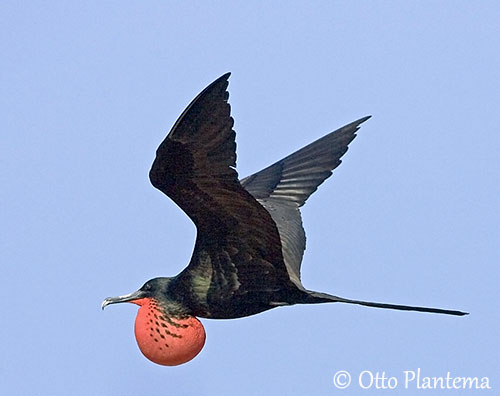
Frigatebirds are superb flying birds well known for attacking and pirating other seabirds. It is suggested that the vernacular name “frigatebird” comes from the comparison with the fast warships used by pirates attacking other vessels. These birds have learnt how to associate with fishermen to steal fish scraps which sometimes are an important source of food.
Frigatebirds were taken by islanders for food. Magnificent Frigatebird’s colonies were harvested, and eggs and young were taken to supplement the deficient diet of humans.
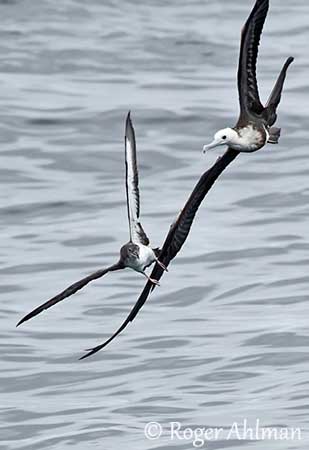
Magnificent Frigatebird juvenile
harassing a Pink-footed Shearwater
Frigatebirds are vulnerable to habitat destruction, disturbances, cyclones and storms which destroy nests, eggs and chicks, introduced rats and cats to islands, increase of visitors and overfishing of predatory fish such as tuna (frigatebirds often catch the fish pushed to the surface by tunas). Several islets are now declared bird sanctuaries and several conservation measures protect these amazing birds.
Around the time of the discovery of America, they were considered to represent good news. For the sailors, the sighting of a frigatebird was an indication that land was not so far. But the same sailors did not know the long time the frigatebirds were spending flying at sea, thousands of kilometres from land…